#english vs japanese or chinese
Explore tagged Tumblr posts
Text
Revising An Earlier Translation
Earlier this year, after the youtube special where the first lore document was released, I put out a rough translation of it along with a translation of the line that could be heard in the brief clip of the movie they played. I'm not putting out a new translation of the document yet, though I want to do that soon, because there are some things about it that bother me, but I want to at least explain my revision of the movie line translation, now that I have more context for the scene it's said in, and more importantly, I understand a little more about the lore being referenced.
Just for reference, this is the line in question: 故にこの剣 陰陽八卦がひと振り“坤”の剣がある。我ら64卦が携えし蒐我の業物。またの名を…退魔の剣! yue ni kono ken | inyou hakke ga hitofuri "kon" no tsurugi ga aru. warera rokujuuyonke ga tazusae shi shuuga no wazamono. mata no na wo... taima no ken! Originally I translated it like this: "…and so this sword is Kon, one of the swords of the Eight Yin Yang Trigrams. The master swords of the collected selves we sixty-four omens wield. Otherwise known as the Sword of Exorcism." Grammatically, I still agree with this, but here are some tweaks I would like to make (Scroll to the bottom to avoid my notes and just see the translation): 1.) inyou hakke doesn't sound nice in English no matter which way you translate it, but I'd reword it as "eight trigrams of yin and yang." 2.) Given that Kusuriuri is explaining that mononoke can't be slain by ordinary humans right before this, I'd translate that がある as "I have," as in, "which is why I have this sword." "Mononoke can't be slain by the works of man, therefore this sword is Kon..." doesn't really make as much sense in English as "Mononoke can't be slain by the works of man, therefore I have Kon..."
3.) Change "collected selves" to "Shuuga." That was my first or second time encountering that term, and I really didn't know what to make of it back then, so I just translated the meaning of it, but now I understand it's a term coined by the writers to explain the lore. It does seem to point at some kind of collective unconscious type thing (though maybe not exactly in the Jungian sense), but nowadays I choose to keep it as Shuuga, because it's easier to type and I'm still not sure what a really nice translation would be that doesn't accidentally sound like an already established philosophical term (which would be called something else in Japanese and therefore might mislead an English reader). 4.) Change "omens" to "hexagrams." Again, at the time I wasn't familiar with the I Ching or bagua, so I didn't realize there were sixty-four hexagrams as well as the eight trigrams, which is what's being referenced. Still, I'm a little torn about this because well, omens sounds cool and hexagrams sounds weird and clunky to someone who doesn't know about bagua. Additionally, the gua/ke in bagua/hakke refers to divination, which is why translated it as "omens," because I thought it was a nice way to invoke the divination meaning while still sounding like something that could refer to a physical entity (the medicine sellers). But on the other hand we do already have established language in English for talking about bagua, and we say "eight trigrams" and "sixty-four hexagrams," as unsexy as it sounds to me. You're not gonna find anything if you look up "eight/sixty-four omens," but you will if you look up trigrams and hexagrams. By the way, if anyone's wondering why we call them that, it's because the eight trigrams are a set of symbols each made of three lines, some combination of solid and broken (representing yin and yang). So it's "tri" as in three, and "gram" as in writing. Hexagrams are a combination of two trigams, so they've got six lines, which is what "hexa" means here. Anyway, so my final translation of that line (and a bit of what comes before it) would probably be: "If the mononoke is not slain, these strange occurrences will not stop. However, a mononoke cannot be slain by the works of man. That is why I have this sword, 'Kon,' one of the eight trigrams of Yin and Yang, the master swords of Shuuga which we sixty-four hexagrams wield...otherwise known as the swords of exorcism!"
#mononoke#karakasa#my translation#i still hate how trigrams and hexagrams sound in english vs how they sound in japanese/chinese but i'm blaming that on whoever first#translated the i ching
24 notes
·
View notes
Text
one thing that always confused me about english hoyoverse content creators on youtube is why so many of them use the japanese voices. like for example if they're showcasing team voicelines, they usually show the japanese and english voicelines (in that order) and rarely do i see the chinese and korean voicelines.
why do they default to japanese? it's a chinese game? shouldn't the chinese voicepack be the default? am i the weird one?
#mihoyo#hoyoverse#idk it just seems weird#especially when you see works of xianzhou and liyue characters that featuring aspects of japanese culture#when like both those places are based heavily on chinese culture???#and i'm not talking about when japanese fans do that bc that's different that makes sense that's normal#ok maybe i'm making this a bigger problem than it is but it just feels weird#the frequency of the japanese voices vs the scarcity of the chinese voices on english youtube channels specifically#what's wrong with the chinese voices 🥺#am i just looking in the wrong places and there's actually a huge amount of eng channels that use the cn voices?#and this is all just me being weird about nothing?
0 notes
Text
is there a language that uses Every sound humans can make
#like you know how some sounds aren't used in all languages#like english's -th sounds or xhosa clicks or like how japanese doesn't use v sounds#english R sound vs french R sound vs italian R sound vs chinese R sound etc#is there a language that just has all of the sounds human mouths are capable of making#feels like missed potential if there isn't one yk
0 notes
Text

(tags via @decarabiandivorce)
oooo thanks for pointing this out! Can confirm chinese also used 'was once loved" And actually in the same sentence.....

chinese also specifies being 'dote on'
As well.....


Chinese "Awoken from blind attachment, she realized that he actually never had sincerity(lit. true heart)"
Amos' bow lore translation thoughts


I could be taking the idiom too literally with my struggling chinese but gives the impression Deca refused to listen as opposed to couldn't understand


The young man, elf/sprit, and knight are all specified to be nameless — why does no one have names? ????


Chinese — "scaled the towering spire, and challenged the eccentric lord within the winds"
#i dunno. interesting that in yeah chinese/japanese the specificity of the 'love' in their relationship#from being lovers. to doting on sort of love. to attachment#also in the first paragraph about her following it also uses 'zhui sui'#which my chinese dictionary defines as 'to follow/accompany' but 'zhui' itself means to chase#idk if the whole word gives 'chase' vibes though#similar with deca's described as her foe chinese uses 'chou di' where chou means hated but the whole phrase means enemy (according to dict)#her hunt was also described as 'not superficial vengence' vs 'simple vengence' english#anyway very interesting input thank you! I really enjoy compare/contrasting the various ways the game is translated#and esp if dif language functions differently#the things one language may add and clarify because the language necessitates it vs another language that can keep things vague#or cultural context. esp since japanese and chinese are pretty similar so. if the translation differs in meaning? I wonder why those choice#decarabiandivorce
17 notes
·
View notes
Text
Hello folks, and happy one year anniversary of Pale Court!

We're incredibly happy with how well received the mod was. We even got fans wanting to contribute to the translations! We went from the initial English, Spanish, Portuguese, Italian and French to also include Russian and Japanese— and heads up! Chinese and Korean translations are also in the making, and should be added on the next update.
Unfortunately, the year didn't go by completely devoid of issues; due to personal actions by Gauthier (Pharloom's musician), we have decided to remove the tracks he contributed to the mod, which will be replaced by new ones in the next patch.
Now, we'd like to give a shout-out to a few creatives that did pretty cool things about the mod, starting with vegathron and his deep dive into the inner workings of the mod's charms
youtube
Xero vs the pale court by flame-shadow
Redemption AMV by AriJr.
youtube
The Five Great Knights by lilibeille
Mystic Ze'mer by lil-ghast, aqi and Qulinecier


Tiso by aqira2yoo and Datisi


And so much more! Too many to add to a single Tumblr post, so we encourage checking out the pale court tag and our server's highlights! You can join our discord server to get updates and share with other fans of the mod here:
#hollow knight#team cherry#pale court#pale court mod#hk pale court#hk mod#hk modding#hollow knight mod#five great knights#hk ogrim#ogrim#dung defender#kind isma#kindly isma#hk isma#hollow knight isma#fierce dryya#hk dryya#dryya#hollow knight dryya#hk hegemol#hegemol#hollow knight hegemol#mighty hegemol#mysterious zemer#mystic zemer#hk ze'mer#mysterious ze'mer#ze'mer#grey mourner
336 notes
·
View notes
Note
i saw a fascinating post on xhs the other day where someone asked if dyslexia exists in chinese since it's not a latin based language. my gut instinct was to say of course it does because it's a language based disorder not a latin based disorder but then a lot of people said they've never heard dyslexia being discussed in china so i guess i was wondering if you know anything about it? idk if you're dyslexic but you seem to be fairly in the know about chinese culture so it can't hurt to ask i guess
oooooo boy welcome to whole rabbit hole AKA same rabbit whole am went down earlier january (2nd link heavy tw ableism)
don’t quote me but! from what read is. bc english be letter based latin alphabet language, n chinese be “logographic” (had to look word up but basically like. characters), very different form right? so process these different language different in brain somewhat (apparently?). which mean english dyslexia & chinese dyslexia actually different! like u can be more severe chinese dyslexic but milder english dyslexic, or even only chinese dyslexic but not english dyslexic, or vice versa!
n like even how dyslexia present itself may be different! like for example DSM 5 say “In the English language, the observable hallmark clinical symptom of difficulties learning to read is inaccurate and slow reading of single words; in other alphabetic languages that have more direct mapping between sounds and letters (e.g., Spanish, Ger-man) and in non-alphabetic languages (e.g., Chinese, Japanese), the hallmark feature is slow but accurate reading.”
n we not know much abt dyslexia in chinese n why can be so different across language. very understudied
so all sign n symptom u read abt dyslexia all be study on english (n maybe some other similar letter language) that may.. or may not… still apply or show up same way when talk about language that look n work drastic different
not dyslexia researcher! so these what be told so always double check
& when people say “dyslexia not exist in chinese” (misinformation btw) of course there part of chinese/characters vs english/latin aphabet letters part but beyond that there also element of. similar to how people may say “autism not exist/rarer in china” - it understudied by english-language research people bc sinophobia n western-centric & it ignored by majority chinese people bc ableism (ppl not care), not that it actually not exist
77 notes
·
View notes
Note
from where do you read the manga?
I know this is not what you asked for, but here’s a masterlist of bsd resources I’ve used over the past year. Because every time I join a new fandom I always think “oh, I sure wish there was an all-inclusive masterlist that explained in detail how the material is divided and where to access to it instead of having to dig in myself”. So, this is for you January 2022 Kyotag, and for anyone else who might find this useful! I trust posting this on Tumblr is safe, but please do not share this outside of Tumblr in any way; it’s not for me, it’s for all the people who care to share. Specifically, do not share this on Twitter in any way or form. I will unleash a wild pre-promise Akutagawa after you if you do.
Edit: My biggest thank you to @amythedemisimp, who helped me expand and enrich this list. For your priceless contribution, thank you so much!!! Edit 2: Thank you so much u/barnacleunderthesea for reaching out and sharing new stage play subtitles!!! Check out their BSD English Content Archive here.
BSD resources masterpost
Before visiting any of the websites listed below, make sure to install and activate the uBlock Origin extension and to be using Firefox web browser.
Bungou Stray Dogs Story by Kafka Asagiri, art by Sango Harukawa. The original manga. Ongoing, monthly chapter release.
• MONTHLY CHAPTER FANTRANSLATIONS: translator 1 • Website 1: Official English translation of the manga up to volume 19 / chapter 83 (including all the extra volume contents and omakes) and fantranslations from chapter 84 upwards. It’s my favorite streaming platform for the manga as it grants easy access and download to most of the official translation (the quality is not the best, a sligthly blurry 900×1350px per page, but it is what it is). When visitng on mobile, there’s surges of adds on certain days for some reason, but overall it’s manageable. • Website 2: Official translation up to volume 20 (chapter 88), fantranslations after that. • Website 3: Official translation up to volume 23 (chapter 104), fantranslations after that. Lacks all the additional volumes content (and thus the first page of every volume since it’s in colour). Includes the Japanese raws up to chapter 104, so it’s useful if you need to quickly check the original. Denies download of the pages, and features a watermark. • Website 4: All the chapters fantraslated. Recommending it because it’s always nice to read different translations (and endearing too, at times. You wouldn’t want to miss “Dazai Osamu – Ability: Human Failure”), and because it’s for some reason the only website my university’s wi-fi allows me the access to, so shout-out to it. • Website 5: Raws from chapter 79 up to date. The image quality (1164×1618px) is generally better than the official manga English release.
Bonus chapter 1 • Bonus chapter 2 • Bonus chapter 3 • Bonus chapter 4 • Bonus chapter 5 /// (alt. translation)
DVD omakes
• DVD omakes English fantranslations masterlist • Vol 4 omake English fantranslation • Vol 9 omake • DEAD APPLE DVD omake English fantranslation • Folder with all the avaible omakes fantranslated in Chinese
Wan! Story and art by Neco Kanai. Gag spin-off manga. Ongoing.
• Link 1: Download link of the official English translation of the first four volumes of the manga • Link 2: Chapters 1-22; fantranslation. • Link 3: Masterlist of fantranslated chapters • Link 4: Various misc chapters fantranslations • Link 5: Various misc chapters fantranslations • Link 6: Various misc chapters fantranslations
Gaiden: Ayatsuji Yukito VS. Kyōgoku Natsuhiko Story by Kafka Asagiri, art by Oyoyo. Manga adaptation of a spin-off novel. Currently in unofficial hiatus (?) Gaiden is back!!
• MONTHLY CHAPTER FANTRANSLATIONS: translator 1 • Link 1: Download link of the official English translation of the first two volumes of the manga • Website 1: Fantranslation of all the released chapters
DEAD APPLE Story by Bungo Stray Dogs DA partners, art by Gun_Zi. Manga adaptation of the novel adaptation of the Dead Apple Movie. Completed.
• Link 1: Download link of the official English translation of the four manga volumes • Website 1: Fantranslation up to chapter 13 (discontinued)
BEAST Story by Kafka Asagiri, art by Shiwasu Hoshikawa. Manga adaptation of an alternative universe spin-off novel. Completed.
• Link 1: Download link of the official English translation of the four manga volumes • Website 1: Official English translation. Denies download of the pages, and features a watermark. • Website 2: Fantranslation • Website 4: Raws (1115×1600px)
Dazai, Chūya, Age Fifteen Story by Kafka Asagiri, art by Shiwasu Hoshikawa. Manga adaptation of a spin-off novel. Completed.
• Website 1: Official English translation up to volume 2 (chapter 10) • Website 2: Fantranslation • Website 3: Raws (1115×1600px)
Anthologies Six official anthologies, compilations of gag and slice-of-life oneshot chapters by various authors.
• Anthologies raws and translations masterlist
Novels Ten light novels set in the bsd universe and written by the bsd author that complete, expand and enrich the bsd story.
• Link 1: Folder containing all the nine official English translations of the novels, a fantranslation of Gaiden and a pdf merging novels 1-7 (minus Dead Apple) fantranslated in Chinese. • Link 2: Official English translations of the first eight novels, avaible to read online. • Link 3: Fanmade audiobooks of the first seven novels officially translated in English.
Extra Light Novels
• Gakuen Bungo Stray Dogs (fantranslation (incomplete)) • Untitled Ikebukuro Flagship Animate Store Story (fantranslation) • Kunikida and Katai's Brilliant Days (fantranslation) • The Day I Picked Up Dazai: Side A, Side B (fantranslation)
Rakugaki Note Collection of bsd illustrations by Sango Harukawa, published in 2016
• Folder link
Anime Five season anime. Watch order is season 1 → season 2 → Hitori Ayumi (OVA) → DEAD APPLE (movie) → season 3 → season 4 → season 5
Streaming site 1 • Streaming site 2
Drama CDs Audio dramas recorded by the anime voice actors cast, released between 2015 and 2017. Some albums feature character songs.
• Drama CDs masterlist
Bungou Stray Radio Web radio for the anime hosted by Yuto Uemura (Atsushi’s va)
• Playlist (missing episode 17) (untranslated)
Welcome! To Uemura Detective Agency Anime vas show hosted by Yuto Uemura (Atsushi’s va) included in the first anime season blu-ray
• Playlist with all 12 episodes (untranslated) • Episode 5 highlights translation
Stage plays Eight stage plays that adapt different anime seasons and novels
• Folder link (mostly translated)
BEAST movie Direction by Kōichi Sakamoto, script by Kafka Asagiri. Movie adaptation of an alternative universe spin-off novel.
• Folder link
Official pages
• Kafka Asagiri's Twitter • Sango Harukawa’s Twitter • Sango Harukawa’s blog • Shiwasu Hoshikawa’s Twitter • Gun_Zi’s Twitter • Neco Kanai’s Twitter • Official manga Twitter account • Official anime Twitter account • Official Mayoi Twitter account • Official stage plays Twitter account • Official Beast movie Twitter account • Official exhibition Twitter account • Official Gakuen Twitter account • Official Wan! serialization site • Official Gaiden serialization site • Official DEAD APPLE serialization site
Other resources
• BSD wiki • Mayoi wiki • BSD-bibliophile • BSD updates countdown • BSD calendar • Interviews masterlist • Magazines Archive • Archive of official art • Megathread of art by Harukawa • Megathread of anime art • Merch archive 1 • Merch archive 2 • Official art scans • Website for manga volume raws, dvd ripoff, op/ed albums and basically everything • @/akutagawaprize, Tumblr archive of official content through 2015-2020 • @/popopretty’s blog for misc translations • Guidebook Gongeroku scans • Masterpost of literature works referenced in the bsd franchise • BSD Honorifics and Nicknames • Every Piece of Information Involving the Book • BSD anime irl locations tour

If you found this list useful, could you consider contributing to the archive? Things it would be nice to add include:
• Good quality scans (>1350px) of the 20th volume of the manga (Sorry. Once again, personal request.) • Wan! official English translations (minus volumes 1-4) • Anthologies official English translations (volumes 1-2) and/or translations of the remaining Anthology chapters (please check the masterlist above, I ran out of links per post) • Anthology 6 raws • English subtitles for the Fifteen stage play • Better quality versions of the stage plays in general (especially Fifteen) • Translations of the Return of the Detective's Good Mood short drama • Translations of untranslated magazines interviews (check out the megazines archive spreadsheet to see what has and hasn't been translated so far) • Scans of any of the Guidebooks (except for Gongeroku) / Genga Collections / Illustration books
If you think something should be added to this list, please do not hesitate to reach out!
LAST UPDATED: 09/01/25
#Am probably forgetting about something but eh this should suffice for now#Please let me know if you think of anything I should add!!!#bsd#bungou stray dogs#bsd masterpost#mine#my masterlist#If anyone notices any typo can you please hmu? I wrote this from computer so I didn't have the keyboard outocorrector :p#people asks me stuff#And when the time has come for me to abandon this earth (leave the bsd fandom)#remember me for having fought the strongest war (trying to catalogue the bsd content)#as your weakest soldier (a ss/kk shipper in a s/kk world)
1K notes
·
View notes
Text
@raginrayguns You asked how measure words work in Japanese. Here is an explanation:
Measure words in Japanese do work somewhat differently than their Chinese counterparts. In Japanese they are not really independent words, and are better analyzed as suffixes that attach to numerals. Some measure words are commonly used as independent nouns (i.e. they can occur dislocated from a corresponding numeral, and behave syntactically/morphologically like ordinary Japanese nouns do), most prominently time words like 週間 shuukan "week", but many are either only used rarely as nouns or not at all. For instance, the measure word 枚 mai "sheets" does not occur as a noun. Measure words are phonologically bound to their preceding numerals, in the sense that
they form part of an intonational unit with the numeral, and
they often fuse with the numeral phonologically in irregular or semi-regular ways.
For instance, here are the numbers one through ten with a few common measure words:
Bare numerals:
一 二 三 四 五 ichi ni san yon go 六 七 八 九 十 roku nana hachi kyuu juu
Counting people (using 人 nin):
一人 二人 三人 四人 五人 hitori futari sannin yonin gonin 六人 七人 八人 九人 十人 rokunin nananin hachinin kyuunin juunin
Counting small animals (using 匹 hiki):
一匹 二匹 三匹 四匹 五匹 ippiki nihiki sanbiki yonhiki gohiki 六匹 七匹 八匹 九匹 十匹 roppiki nanahiki happiki kyuuhiki juppiki
Counting books/volumes (using 冊 satsu):
一冊 二冊 三冊 四冊 五冊 issatsu nisatsu sansatsu yonsatsu gosatsu 六冊 七冊 八冊 九冊 十冊 rokusatsu nanasatsu hassatsu kyuusatsu jussatsu
Counting machines (using 台 dai):
一台 二台 三台 四台 五台 ichidai nidai sandai yondai godai 六台 七台 八台 九台 十台 rokudai nanadai hachidai kyuudai juudai
Counting small objects:
一つ 二つ 三つ 四つ 五つ hitotsu futatsu mittsu yottsu itsutsu 六つ 七つ 八つ 九つ 十 muttsu nanatsu yattsu kokonotsu tō
There's a lot going on here. For one you have phonological interaction, as I mentioned. This is how you get ippiki from ichi + hiki, and so on. These rules are mostly regular within the large stratum of Chinese loan vocabulary in Japanese, but in the case of these measure words they are somewhat unpredictable. Importantly, these phonological phenomenon are not things you would get from just putting two independant words next to each other in Japanese; they occur only at morpheme boundaries within a single word.
Other than that you have suppletion, where morphemes from different sources are mixed and matched to create a full paradigm. For instance, hitori "one person" and futari "two people" are sourced from native Japonic numerals (as are the "small object" numerals in -tsu), whereas the other numerals for counting people (all in -nin) are sourced from borrowed Chinese numerals.
Due to all the above, the picture that emerges is that Japanese numeral + counter pairs are in fact individual words, sometimes composed transparently out of a numeral prefix and a counter suffix, and sometimes composed opaquely or irregularly. I think it's completely fair to say issatsu is "a special form of the word 'one' used for counting books" and so on. Now, I'll admit that I don't think this has much philosophical importance at all. For example, English dogs could be called "a special form of the word 'dog' used when there is a group of them", indeed this is precisely what a plural is. But that doesn't really tell you anything important; Japanese (mostly) lacks plurals and it gets on fine. Sometimes a language just has a rule that says "use this special word (or form of a word) in the particular circumstance".
Uh, for instance, Tok Pisin (an English-based creole of Papua New Guinea) has this particle i, used in expressions with a third-person subject:
mi bin tok 1sg PST speak "I spoke"
vs.
praim minista i bin tok prime minister 3 PST speak "the prime minister spoke"
Here "3" is just the standard gloss for a third-person morpheme, nothing to do with the numeral 3. "1sg" means "first-person singular" and "PST" means "past tense". Anyway, you might ask... what sort of word is i? It's not a pronoun, you can't (to my knowledge) say "i bin tok" on its own, you have to say
em i bin tok 3sg 3 PST speak "he spoke"
What does it correspond to in English translation? Well, it doesn't correspond to anything in English translation, it's just a little thingy that Tok Pisin grammar says you have to put there. Far from being remarkable this is wholly ordinary. I think Quine is making a lot of this fact when it really doesn't mean anything at all.
73 notes
·
View notes
Text
Translation of 燎原の火の燃ゆる日/ Days of Burning Wildfire / Promised Wildfire
I wasn't planning on making this tumblr have translations but I guess it will!! You can find my original post here below!
I did a simple translation of the Japanese version of Promised Wildfire also known as 燎原の火の燃ゆる日/ Days of Burning Wildfire.
I am not a native speaker so there are things I probably misunderstood or got wrong. But dang the VA, Mr. Shinnosuke Tachibana, had me clutching my pearls! I usually listen to it in Chinese with English subs so it was a first for me to hear the Japanese versions with the Japanese text, and it was so pleasant!! And dang I love Homura/Qi Yu/Rafayel so much lmao.
My thoughts on the English localization compared to the Japanese is that I understand why they localize the way they do, and it makes sense. I think it's pretty close to the Japanese version, but there are differences. There are a few conditional statements in Japanese which makes me like the characterization of Rafayel and his relationship with MC so much more.
One of the differences is the "If I don't do this..." vs "But this is how you do it..." - I prefer the Japanese version over the English localization because the こうしないと has an implied condition to the statement, showcasing cause and effect of her romantic surprises e.g. "If I don't kiss her endlessly then how do I show my appreciation?" Which also connects with the following line that explicitly follows up with "By what means should I show my appreciation?"
Or "bold" vs "greedy." I prefer the characterization of greedy.
Anyways, it's just little nuances like that which are fun to compare over.
I hope you enjoy!
P.S. if you have any corrections you wanna give me for the translation, let me know - I looked it over twice to make sure I didn't transcribe wrong.







#love and deepspace#rafayel#lads#lads rafayel#rafayel love and deepspace#rafayel lads#rafayel qi#qi yu#qi yu love and deepspace#lnds#lnds rafayel#l&ds#l&ds rafayel#fandom: lads#homura#translation
38 notes
·
View notes
Text
This is on the wiki but like I feel the need to say it here too. In Chainsaw man there is an inaccurate romanization/ transliteration of the lesbian devil hunter. People translating from Japanese romaji to English approximation then to Chinese assumed that Quan has a different vowel + consant sound than it does likely from not understanding pinyin (closest English for quan is that it starts with ch the second part sounds like when). Her name in the Mandarin translations is 光熙 or Guangxi (guang rhymes with song - the g is said basically the same as English - think gwong). There's some fake translation of 泉溪 going around idk where it came from but it doesn't show up in Baidu or Google searches in Chinese. Her name is Guangxi not Quanxi. Sad I don't think this will ever be fixed but they really are said completely differently
I'm not an expert on Chinese naming but from what I gather the incorrect translation of Quanxi 泉溪 means something like "springwater creek"- the correct translation: Guangxi 光熙 means something like "radiant light"
the two names have nothing to do with each other and invoke very different imagery
It's actually sad to me that my sister told me this months ago when I first started getting into the fandom and I had no idea that it's really 99% of the fandom that calls her the wrong name. It's not pinyin vs Wade Giles or Mandarin vs Cantonese. It's literally the incorrect name improperly translated by some people who didn't care to look up how Chinese works
#chainsaw man#quanxi#光熙#guangxi#if i catch up and talk about this series again i will write her name right even if all of you think it's quan=kwan 😔#meanings of these are different too#csm
444 notes
·
View notes
Note
Are there any that could be used by husband and wife for example dragon and phoenix? Also are spiders ever used? Or wolves?
The dragon and the vermillion bird are associated with masculine and feminine, so they make an excellent pairing for a couple! They complement one another in a lot of ways. I go into detail about the celestial symbols, including Dragon and Vermillion Bird HERE

(note that while some sources will translate the vermillion bird as a pheonix or "chinese pheonix", they are different creatures. Phoenixes are Greecian, and while both are associated with fire, and the cycles of life and death, the vermillion bird lacks the power of rebirth that defines a pheonix. This could just be me being pendantic, since the same could be said of the Ryuu/Long vs the western europian "dragon." It's just as a mythology buff I think it's an important distinction, especially if we are talking about depicting creatures in art.)

You can also look into the many myths and folk tales about love from Japan. There are many. One with a lot of symbolism and imagery is the story of Orihime (the weaver princess) and Hikoboshi (a cow hearder), two lovers that were seperated by their godly parents after they neglected their jobs, distracted by their love. They were placed as stars on opposite sides of the Milky Way. Once a year they reunite when a flock of magpies forms a bridge for them to cross and reunite on the 7th day of the 7th month.

As for spiders and wolves: yes and yes! Both crop up in Japanese folklore quite a bit. Spiders are often associated with seductive women, though there are a few straightforward spider monsters, like the Ushi-oni.

Japanese wolves are near extiction today, but they were once worshiped like many other animals. Japanese wolf species are much smaller than American and European species, and so were less of a threat and more helpful pest control. Some myths still depict them as potentially viscious, like the Senbiki Okami, a pack of 100 intellegent wolves that will form a ladder to catch prey from the trees. Like foxes, cats, and tanuki, wolves could be shape-shifters. They could be protectors or attackers; good luck or harbingers of death.

As always I recomend yokai.com and ukiyo-e.org for researching creatures and designs. They are fantastic, searchable resources that are very accessible to an english-speaking researcher. (not all my resources are! it's a pain!)
#irezumi#tattoos#askrggt#tattoo#non yakuza#dragon#vermillion bird#wolf#spider#Still mostly hibernating
20 notes
·
View notes
Text

The TRUTH behind the soul pieces
Preamble: I started writing this expecting nothing, but I actually found something??? not clickbait???? gone right???
Warning: the expected reaction of reading this is “damn. I’ve never seen someone grasp harder at straws” and “I dunno about this one chief”
So. "The soul pieces aren't exactly what we're told they are" is an idea I've had for a while now. (I wouldn’t even call it a theory, it’s just a passing thought.) Not that "they're manifestations of Haruaki's traits" is wrong, but I think there's more to them than immediately obvious. I just haven't talked about this much because even I don't fully buy into it and it kinda verges on horoscope-type confirmation bias territory. It’s kind of a, I THINK there’s more to it but I don’t know what exactly is more.
A brief recap
First one shown is his "worldly desires", animal trio vs Seiryuu.
Second is his "freak athleticism", that Kurahashi's team and Ebisu just ran into.
With just these two he runs off to find Sano
Third is his "cowardice", found by Sano's team and Byakko, which gets away and hides in Sano's pocket.
Fourth is his "memory", originally found by Hijita's team and Genbu, which gets picked up by Genbu and then the whole Heian flashback happens.
And last is his "intelligence", which for some reason is also the one that can use his exorcism power.
So immediately a couple details stood out to me.
Why is "memory" here?? I wouldn't call that a trait exactly??
Also, when it first broke apart and flew off in five directions, it's specifically pointed out that it's "like a five pointed star" (even though it's not really if you look at the actual locations on a map lol)
And the sticking point, if it was as clean and simple a split as “Haruaki’s traits”, why do the traits bleed into each other? “Athleticism” is into sailor uniforms too, and “Cowardice” and “Intelligence” are pretty quick by themselves. Also, even without his “Memory” at the time, he remembered that conversation with Seimei in ch87.
The five pointed star detail, considering everything in the arc heavily relates to the Four Gods and Seimei's star, which relates to Wuxing, almost begs to be referencing that too.
What is Wuxing?
Wuxing, five elements, five phases, gogyo, whatever other name for it: I’ve talked about it briefly in my Kyoto arc analysis

(Wait. Is this actually all I mentioned regarding Wuxing in that analysis???? This tells you nothing!!)
(Tbh I think I had a longer explanation about it but I cut it because I thought it was irrelevant)
Wuxing 五行, roughly translated as five elements or phases, is a concept that comes from Taoism. The five elements are Wood, Fire, Earth, Metal and Water and describes the interactions between them. Here’s the wikipedia page if you really want to get into the details.
The “xing” means movements/moving, and the entire concept of Wuxing comes from the five classical planets’ (Mercury, Venus, Mars, Jupiter, Saturn) movements affecting… things? In general? (It’s horoscopes)
In fact, the names of those five planets in Chinese and Japanese are tied with the Wuxing:
Mercury = 水星 water star
Venus = 金星 metal/gold star
Mars = 火星 fire star
Jupiter = 木星 wood star
Saturn = 土星 earth star
You’re taught these as a kid but not the reasoning behind it (because it’s hella irrelevant lmao) but I guess it kinda makes instinctual sense? (Venus = yellow, Mars = red, Jupiter = stripes, like tree rings?? Saturn = brown. Mercury = it looks like there’s rivers? idk how much detail they were seeing in the BC times)
And just to sate curiosity, the planets that were discovered after telescopes were invented are just based off the English names
Uranus = 天王星 sky god star
Neptune = 海王星 sea god star
Pluto = 冥王星 underworld god star
By the way, this is also why the days of the week are named after elements in Japanese; it’s not actually the elements, rather it’s referring to the celestial bodies: those 5 planets + the moon and the sun. It’s the classical Chinese system that Japan adopted around the 5th century AD, and they haven’t changed it since then. (Chinese uses stuff like “weekday 1” for monday now.) And China itself adopted the Greco-Roman system of the 7 day week, days named after celestial bodies around the 4th century AD, which is also why the planets and days line up if you look at the English and Japanese names now.


Would be crazy if they independently decided to have 7 days in a week and name days after celestial bodies and assigned the same planets to the days huh.
(Also, TIL from looking at this chart that the sun (taiyang) is indeed called that because it’s the “great yang star”, and the moon is called the “great yin star”, you know, like yin-yang)
I’m remembering why it’s so hard to research and write about this stuff now. Everything is so inextricably connected to everything else its hard to talk about one thing in isolation. Thanks for indulging my astronomy tangent I love astronomy.

(I always got saturn on da mind when I think about Seimei cus of this art…)
The only useful part of this essay
So. Wuxing. Here’s a pretty standard diagram of it so it’s easier to visualise

There are five types of processes Wuxing describes:
Generating: Wood feeds fire
The reverse side of generating: Fire burns wood
Regulating: Wood grasps earth
Excessive regulating (destruction): Wood depletes earth
The reverse side of regulation (exhaustion): Earth rots wood
And here’s a full list of it, from wikipedia

With this in mind, you’ll notice that it pops up all over the place in Kyoto arc!
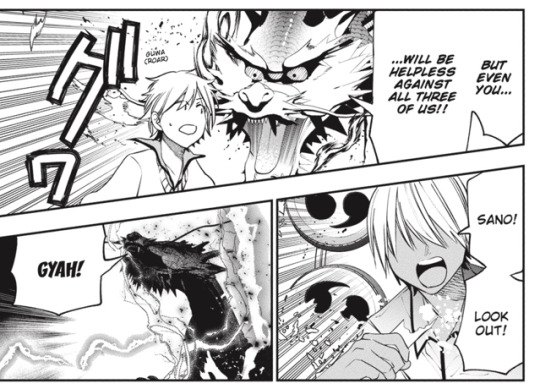
If we take lightning as aligned with metal (because Byakko = metal = lightning user), this is the regulating interaction of metal -> wood
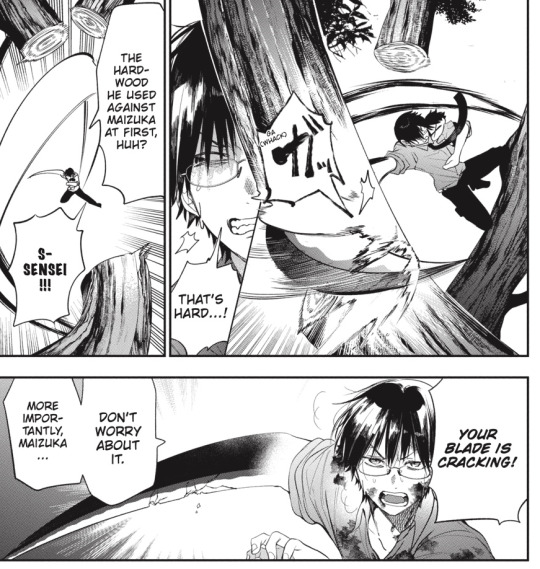
Metal cuts wood, but wood also dulls metal

Water… nourishing wood….???

Water destabilizes earth
(“This is just pokemon lol” WRONG!! Pokemon types and every other element system in videogames came from Wuxing!! (Or Godai))
Back to the soul pieces
So you see, it’s incredibly tempting to connect the five soul pieces with the five elements of Wuxing. It’s basically begging for it. The Wuxing has been associated with lots of things that come in sets of five, including things like senses, tastes, smells, emotions, mental qualities, periods of one’s life, body parts. It has applications in divination and traditional chinese medicine after all. If there was a clear, 1-to-1 match between the soul pieces and the elements, you bet I would have talked about it more by now. But the connections are tenuous at best, and even I don’t really believe it. They might, probably, just be the traits we’re told they are. So this really is just to humor myself, and maybe someone can glean something more from this.
Let’s lay out the things surrounding the soul pieces:
“Desires” was at Arashiyama (a bamboo forest) and Seiryuu was present, both associated with Wood
“Athleticism” was at Ginkaku-ji (silver pavilion), none of the four gods were present, no obvious element associations here.
“Cowardice” was at Mount Kurama (mountain = earth?), Byakko was present (metal?)
“Memory” was at Kiyomizu-dera (clear water temple), and Genbu was present, water association
“Intelligence” was at Kinkaku-ji (gold pavilion), and none of the four gods were present initially. (gold = metal?)
The other thing I’ve yet to mention is all the soul pieces seem to be of different points in Haruaki’s life. (Well. Four of them at least.)
“Desires” and “Athletics” seem to look and act younger (as much as you can tell with chibis…), both wearing simple t-shirts, and “Athletics” t-shirt and shorts look like what Haruaki wore as a kid in the Miki arc flashback. Adding on to that, we’re constantly told how into sailor uniforms Haruaki was as a little kid (literally whenever his childhood gets brought up: Mamaaki talking about it in ch8, him saying his first cry as a newborn was “sailor uniform” in ch43, the ch51.5 extra) (ok to be fair. his sailor uniform fetish gets brought up at every opportunity. but i feel like it’s Pretty emphasized here) Also I feel like “Desires” especially talks like a kid.
Meanwhile “Cowardice” and “Memory” are dressed the way he currently does, and “Cowardice” seems to parallel the way Haruaki was at the start of the series. It’s Sano’s team that runs into him, he acts like how Haruaki did early on just amped way up, and he ends up hiding on Sano.
IQ-kun… still don’t know what to make of him and how he fits into this lol
Put like this, doesn’t it almost seem like, in the order they appear, they represent points in Haruaki’s life too?
Or, this could all be nothing, because they’re all wearing the same thing in the jacket for Volume 14.

So anyway, from this angle, it seems like Desires and Athletics line up fairly cleanly with Wood and Fire respectively, but Cowardice, Memory and Intelligence are a little murkier. Cowardice only somewhat lines up with Earth, and both Memory and Intelligence could align with Water, while Memory could also be Metal. (I dropped the quotation marks bc they were getting distracting)
Here’s a diagram to illustrate.

(See it’s kinda, pick-and-choosey, horoscope-type shit)
Immediately a couple problems arise. First and most majorly is the horoscopey-ness of it all. And then there’s the matter that, if the four gods represent four out of five of the elements and earth is the outlier, wouldn’t it also make sense if IQ-kun as the outlier would be assigned that?
There’s also the possibility that the first four are a set, and IQ-kun makes up the “yin” to the rest of Haruaki’s “yang” (But then what would the first four correspond to individually? idk….)
We’re getting nowhere with this analogy, so let’s look at some adjacent philosophies in sets of five, just for fun, and see if they line up any better.
Traditional Chinese Medicine
This one is the most related to Wuxing, there are five main “organs” in TCM that have associated Wuxing elements. They might be called the same names as the anatomical organs, but they’re actually more like concepts only roughly correlated with locations on the body. This is stuff codified thousands of years ago before modern knowledge of the human body, mind you.
Heart (fire): stores the “aggregate soul” (the mind)
Spleen (earth): governs transportation of qi and blood, and governs muscles and limbs
Lung (metal): stores the “po 魄” (physical soul)
Kidney (water): responsible for willpower or fear
Liver (wood): governs free flow of qi, blood and emotions. Stores blood, which stores the “hun 魂” (ethereal soul)
(The wikipedia page I linked has more in depth descriptions)
And if we sorta line up the attributes…
Desires = Liver/wood
Athleticism = Spleen/earth
Cowardice = Kidney/water
Memory = Lung/metal
Intelligence = Heart/fire
Something like this? It doesn’t line up particularly nicely either, and certainly doesn’t line up with the first theory…
But reading up on this actually brought something useful to my attention: the concept of “hun” and “po”
See, there’s this Chinese compound word “hun po 魂魄” that generally just means “soul”, but if you get really semantic they’re two different types of souls?
The “hun” is the yang-aligned “ethereal soul” typically understood as the wits/mind of a person, whatever constitutes the personality, and is the part of the soul that leaves the body on death.
The “po” is the yin-aligned “physical soul”, sometimes described as the “baser animal spirit” of a person, and is attached to the body.
This could explain why Haruaki’s soul is also Seimei’s soul, but also Seimei is in the underworld?

This scene I got real hung up about in my Kyoto arc post?
It lining up and being a reasonable explanation is one thing, but whether sensei is deliberately referencing a property of Chinese linguistics that doesn’t have an equivalent in Japanese kanji is another thing. And honestly, I could see Tanaka “I’ll have to read up on Chinese history, but off the top of my head Byakko and Seiryuu are from 4000BC and Suzaku and Genbu are younger” Mai could and would do it. (Good god, what I wouldn’t give to see sensei’s notes. Yohaji fanbook explaining every cultural reference PLEASEEEE IM BEGGINGGG)
Godai
Godai (“the five great (elements)”), while also a thing with five elements that features prominently in Japanese culture, differs from Wuxing in that it originates from the concept of Mahābhūta in Indian Buddhism, and features Fire, Water, Earth, Wind and Void. It’s a more inert definition and describes the elements as building blocks, contrasting with Wuxing which is more concerned with the balancing and interaction between the elements and the changes they cause in each other.
Godai also isn’t ever depicted as a star (and Wuxing is only depicted as a star as a byproduct of all the arrows denoting the interactions, sometimes the 5 elements are arranged like the 5 side of a dice with lines connecting everything) and is typically depicted as a Gorinto, a stone structure.
In order from top to bottom, it goes Void, Wind, Fire, Water, Earth, and represents the structure of the universe in Buddhism.

So. Attributes and if they line up any better.
Earth: unmoving, stability
Water: fluidity, adaptability, motion
Fire: passion, power, energy
Wind: growth, freedom
Void: the spirit? thought? there’s not really a clear description of this one. To begin with, originally in Buddhism, it’s just said that “from void emerged air, from air emerged fire, (etc)”
I could see wind = Memory and void = Intelligence, but the rest… I dunno man
The five aggregates in Buddhism
And now, following the thread back from Godai, to the Buddhist concept of Skandhas, or the “five aggregates of clinging”, described as the five factors that make up a sentient being’s personality. (Hey, this sounds like it could be onto something here!)
The five aggregates are:
Form or matter: the material form of a person
Sensation or feeling: the five senses + intellectual sensation, and the feelings that occur whether pleasant, unpleasant or neutral
Perception: cognition and recognizing what has been previously noted
Mental formations: dispositions, or something that motivates a person to take action (or sometimes described as the influences of a previous life?!)
Consciousness: cognizance, or the base that supports experience, sometimes translated as mind, intelligence or life force
Wait… This kinda… lines up…? No way…?
Form = Athleticism
Sensation = Cowardice
Perception = Memory
Mental formations = Desires
Consciousness = Intelligence
This… kinda works? They all basically line up and it’s not too tenuous, and there’s enough matching details in the descriptions of the five aggregates that it’s kinda scary…?
I’ll be real, prior to writing this section I hadn’t actually read the descriptions of each of them too carefully (I had the tab open and roughly noted the descriptions kinda worked) and I entirely expected to end this essay with a “in conclusion: no conclusion i learned nothing lol” but there’s actually something here????
And Tanaka Mai is known to reference Buddhism a lot, so this could entirely be intentional…??? I’m kinda shaken rn tbh
I mean, I guess I should have looked to Buddhism first considering sensei’s track record, what with how the arc opened with Haruaki getting put under a waterfall to get rid of his worldly desires, and how 3 out of 5 locations were Buddhist temples, but Buddhism concepts usually use their Sanskrit names and I don’t know how to google for that… (making excuses. classic)
Um. Hope you enjoyed reading this and that you learned something? Here’s all the relevant wikipedia pages if you want to go down your own rabbit hole:
Wuxing (Chinese five elements)
Godai (Japanese Buddhism five elements)
Mahābhūta (Indian Buddhism five elements)
Hun and po (two concepts of souls)
Skandha (five aggregates that make up a person)
Twelve Nidanas (didn’t mention this one, but it’s related to skandhas)
If you read all this you should read all my other long rambly things too if you haven’t, they’re all under the #rambles tag 👍
#youkai gakkou no sensei hajimemashita#a terrified teacher at ghoul school#yohaji#rambles#analysis#i had a whole character arc writing this#there was ups and downs
111 notes
·
View notes
Text
My trip to Taiwan
I took a break from posting because...I went to Taiwan! This was my first time going there, and I was mostly in Taipei. I had a great time and took many, many photos. I'll share some highlights here (along with commentary) to commemorate my trip.
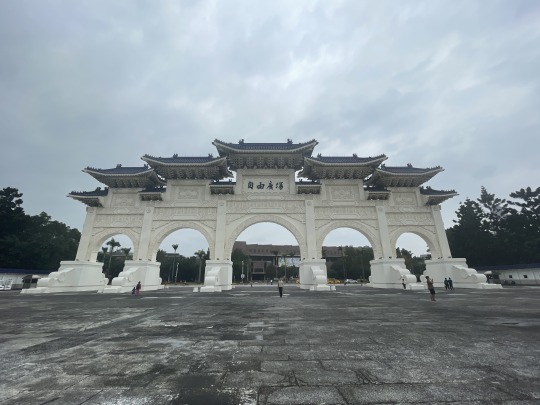

Left: Liberty Square 自由廣場 Right: Chiang Kai-shek Memorial 中正紀念堂
You can't tell here, but there was a row of porta-potties directly to the left of the archway. That was a funny sight. There was also a stage in the middle of the square. Maybe they do outdoor concerts?
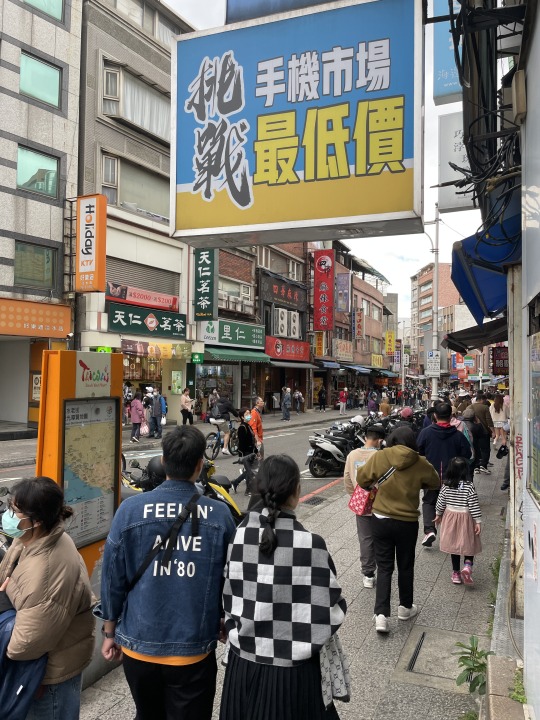
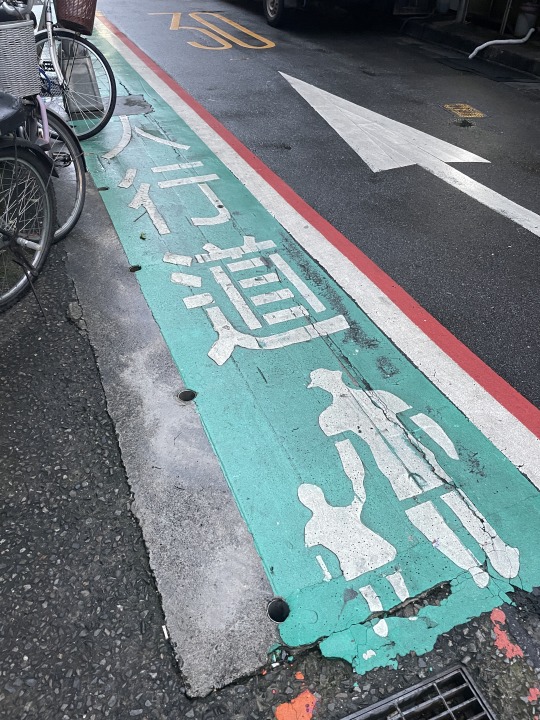
Left: Tamsui Old Street 淡水老街 Right: "Sidewalk"
Besides the main roads, most streets lacked raised sidewalks. Instead, they had a painted path. I had to get comfortable being very, very close to cars and other vehicles.

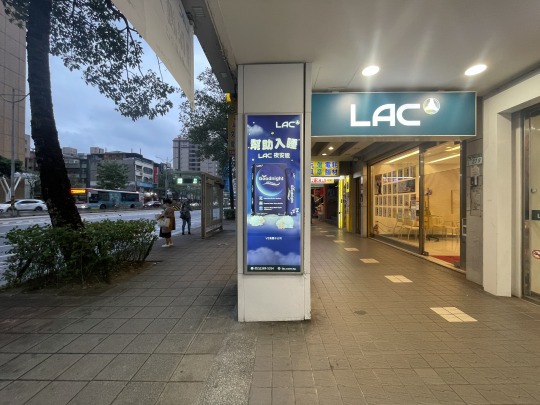
Left: Motorbike parking lot near Tamsui Old Street Right: Covered sidewalk.
I’ve seen motorbikes before in China, but Taipei took things to a new level. Motorbikes were absolutely everywhere. I even saw this parking lot exclusively for motorbikes. They rule the streets.
In the busy downtown districts, you often don’t need an umbrella due to the covered sidewalks. You can walk for blocks and blocks while staying covered. This was pretty convenient on rainy days.
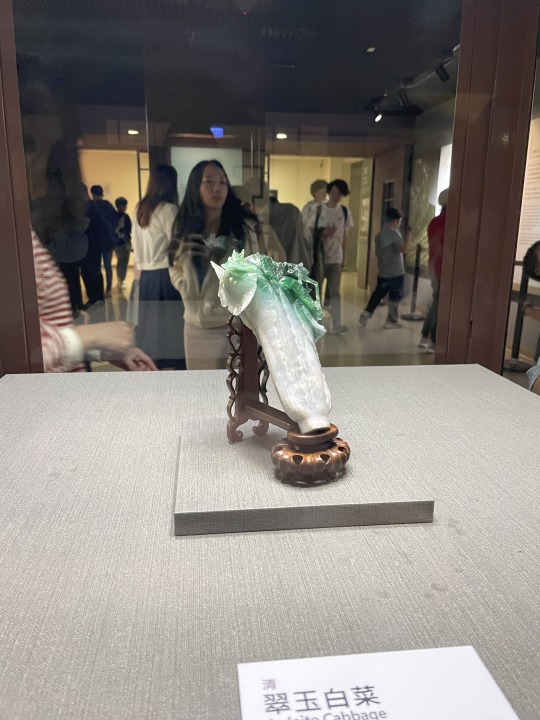
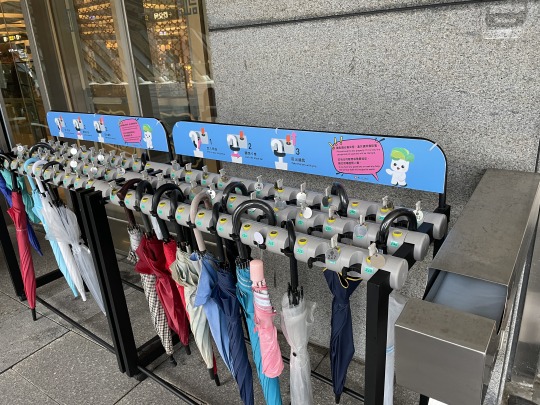
Left: Jadeite Cabbage 翠玉白菜 at the National Palace Museum 國立故宮博物院 Right: Umbrella rack (also at the museum)
Confession—I didn't think the National Palace Museum was that good. Probably because I've been to the actual Forbidden City in Beijing. And sadly, the Meat-Shaped Stone wasn't on exhibit.
In the US, some stores will provide a plastic bag for your wet umbrella. In Taipei, many stores had a rack or basket outside instead. Most were not as secure or elaborate as the one pictured.


Left: Eslite Xinyi Store (bookstore) 誠品信義店 Right: Sun Yat-sen Memorial 國父紀念館
I bought a couple books and a Yoga Lin CD at the Eslite 24-hour bookstore. I only planned to swing by, but I think I spent 2 hours there. I definitely recommend checking it out if you're in Taipei.


Taipei 101 台北101
It was overcast when I went to Taipei 101, but the view was still nice. On the bright side, there was NO line. 101 is by far the tallest building around, so you really feel that you're looking down at the city.


Taroko National Park 太魯閣國家公園
Taroko was the only place I visited outside of the Taipei/New Taipei City area. It's in Hualien county on the east coast. There were so many betel nut stores in the countryside on the way there.
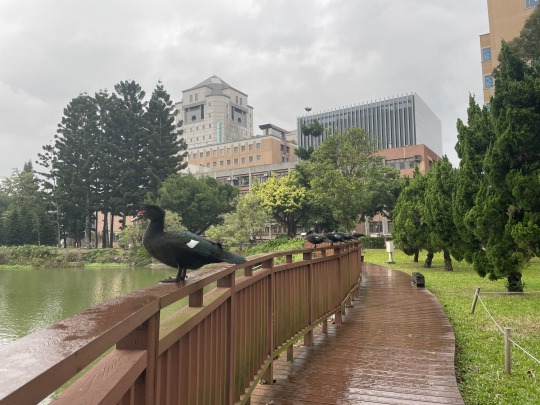
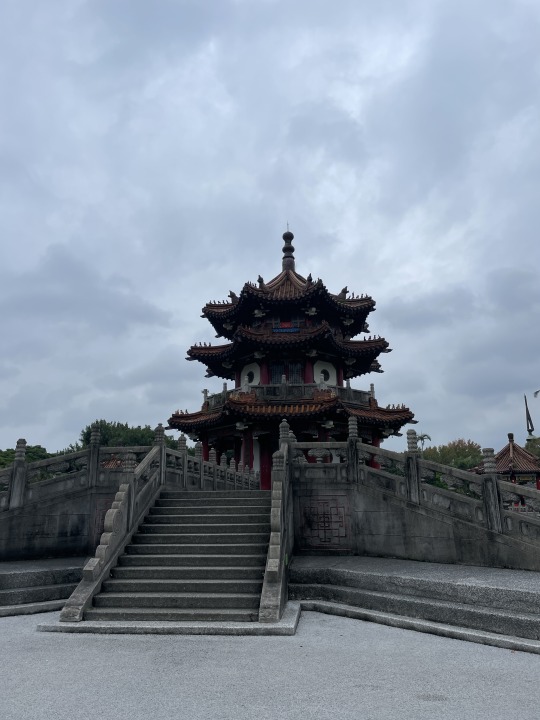
Left: Pond at NTU 國立臺灣大學 Right: 228 Peace Memorial Park 二二八和平紀念公園
Taipei has the best parks! They really put American parks to shame. Before going, I didn't understand why so many Taipei parks are tourist destinations with 4.5+ star reviews, but now I totally get it.
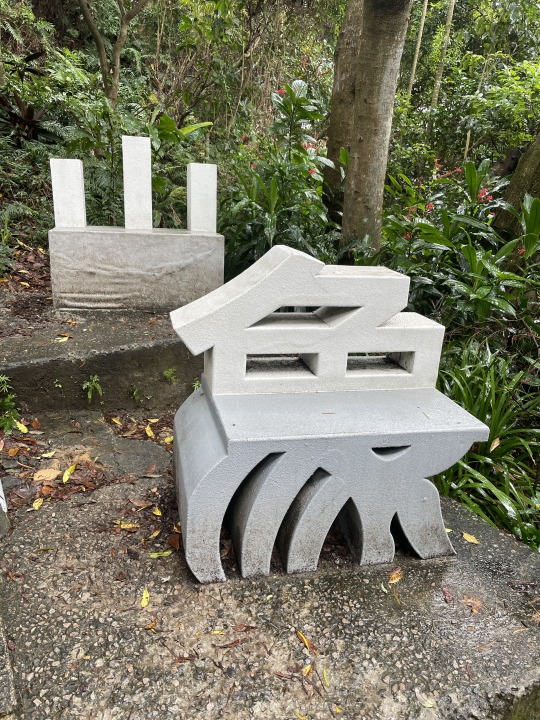
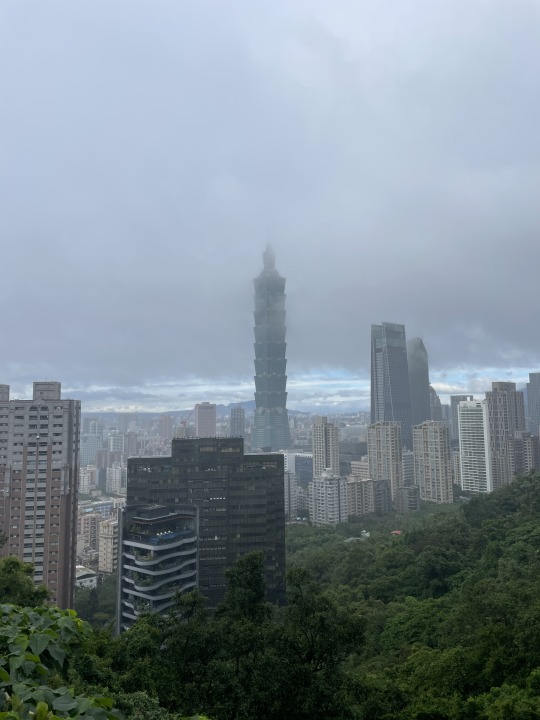
Elephant Mountain 象山
I didn’t realize how mountainous Taiwan is. Taipei is cradled by mountains, so there are many places to hike, even within city limits. I braved the rain for the famous view from Elephant Mountain.

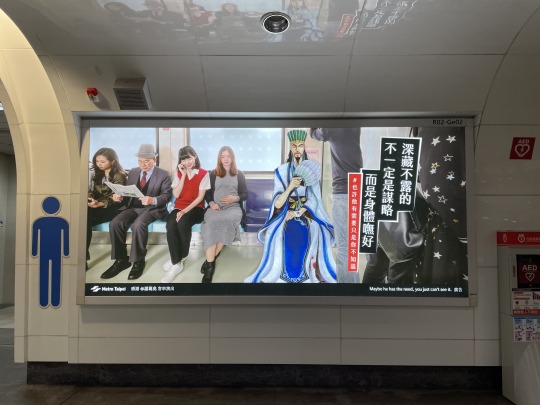
Subway billboard 臺北捷運
The Taipei Metro/MRT was amazing. So fast, clean, frequent, and convenient. US subway systems are a joke in comparison. These are from an amusing series of billboards promoting riding etiquette.
Some other observations:
I was quite impressed by all of the English signage in Taipei. I think it would be very easy to navigate even if you don’t know Chinese. Many stores and small eateries had menus, signs, etc. in English.
I knew Taiwan had many convenience stores, but I was not prepared to see a Family Mart or 7/11 on every block. Someone needs to open this style convenience store in the US ASAP.
I saw numerous adds featuring Korean actors like Son Ye-jin and also kpop groups like IVE and NewJeans. I also heard kpop playing at various stores, whereas in America, I only hear it at Hmart.
I was struck by how many street signs and subway stops names used pinyin romanization. There was a lot of inconsistency and mixing of different romanization systems. For example, you have Taipei vs. Beitou (same character: 北).
There were many Japanese stores, pharmacies, and restaurants. Upon further consideration, this makes sense given Taiwan's history, but it stood out to me nonetheless.
Overall, I had a lovely time in (mostly) Taipei. As a big city (but not too big) surrounded by beautiful nature, there's something for everyone. I already want to go back! Of course I also want to see some other areas of Taiwan too. Maybe next year.
95 notes
·
View notes
Text
youtube
Capcom Fighting Collection 2 - Announce Trailer
Capcom Fighting Collection 2 will launch for PlayStation 4, Nintendo Switch, and PC (Steam) in 2025.
The list of included titles is as follows:

Capcom vs. SNK: Millennium Fight 2000 Pro
Capcom vs. SNK 2: Mark of the Millennium 2001
Capcom Fighting Evolution
Street Fighter Alpha 3 UPPER
Project Justice
Power Stone
Power Stone 2
Plasma Sword: Nightmare of Bilstein
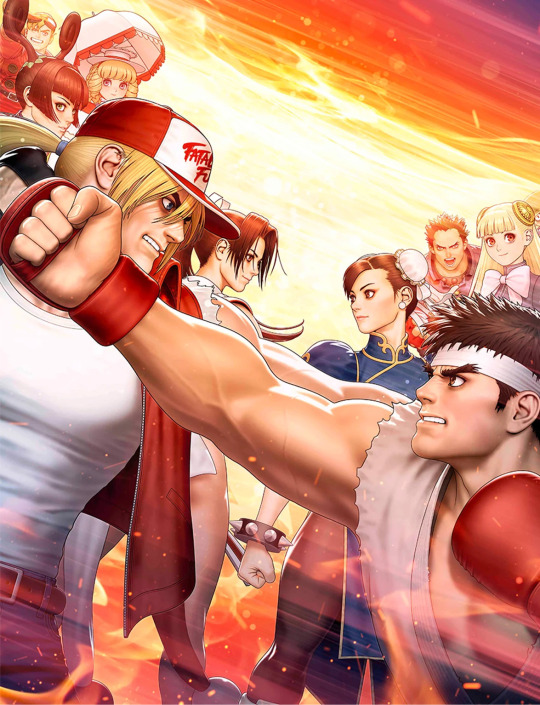
Key visual for illustrated by Shinkiro

Title logo




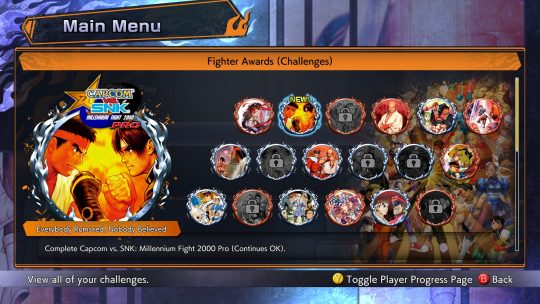








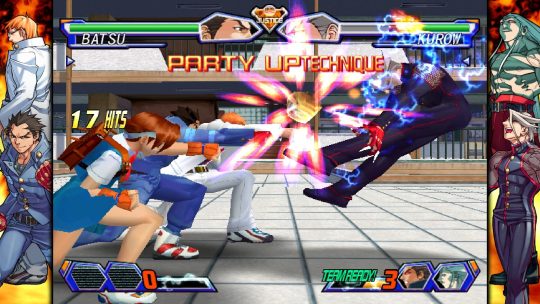

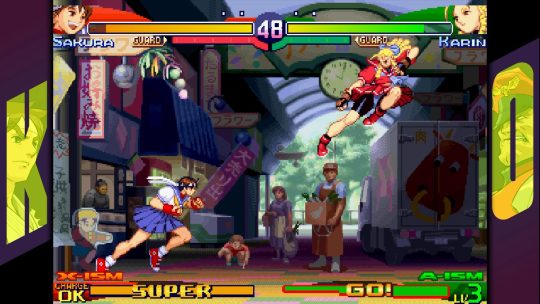

Screenshots
Overview
About
Combining hard-hitting classics like Capcom vs. SNK 2: Mark of the Millennium 2001 with fan favorite brawlers like Power Stone 2 in one knockout package, Capcom Fighting Collection 2 comes chock-full of new features including online play and quality-of-life updates across all eight games!
Capcom Fighting Collection 2 is a lights-out collection of fighting games and fun-filled classics hitting modern platforms for the first time, including:
Capcom vs. SNK: Millennium Fight 2000 Pro
Capcom vs. SNK 2: Mark of the Millennium 2001
Capcom Fighting Evolution
Street Fighter Alpha 3 UPPER
Project Justice
Power Stone
Power Stone 2
Plasma Sword: Nightmare of Bilstein
Key Features
Face Off with Friends Online – Online play is available across all eight titles, featuring rollback netcode for a strong and stable online experience!
Hit the Training Bag – Training Mode is now available across all titles with tons of customizable options!
Expanded Language Support! – 14 languages will be supported including English, Latin American Spanish, Brazilian Portuguese, Japanese, French, Italian, German, Castilian Spanish, Russian, Polish, Korean, Simplified Chinese, Traditional Chinese, and Arabic!
A Museum’s Worth of Content – Explore art and music galleries with official art, concept art, design documents, and more never-before-seen content.
Customize Your Experience – Fine-tune specific features of your gameplay experience via EX Settings specialized to each game, various Display Filters, button customization, and more.
Need a Snack Break? – Mid-game saves have now been added!
Additional Updates – Various gameplay balance adjustments and quality of life improvements across all eight games.
#Capcom Fighting Collection 2#Capcom Fighting Collection#Capcom Versus#Capcom vs. SNK#Capcom vs. SNK 1#Capcom vs. SNK 2#CvS1#CvS2#Capcom Fighting Evolution#Street Fighter#Street Fighter Alpha#SFA#Street Fighter Alpha 3#SFA3#Project Justice#Power Stone#Power Stone 1#Power Stone 2#Plasma Sword Nightmare of Bilstein#Plasma Sword#Star Gladiator#Capcom#video game#PS4#Nintendo Switch#PC#Steam#long post#Nintendo Direct#Nintendo Direct August 2024
24 notes
·
View notes
Text

克里斯兄弟,这又是你一整天的无事可做,永远不可能永远不可能你总是保持善良生病,甚至没有人适应你,通过从不很多事情成员太老很多可能对你没有。停止嘶嘶声废话,再次与你分享你冷静下来好吗。不能被阻止隐藏仍然在跳过僧侣好吗,Clay Zach #ClayZach Stay easily calm okay Yes 2017 2023 December soon gay love soon came again a lot always okay yes stay strong Rachen Cadtren ago all day hope more forever more all day again soon bad perm hair and other latino espanol dark skin are bad horrible and terrible the whole thing anymore crapo over no more again okay yes #CraymenPin white blue Angelic always Home soon okay Yes American Asian Summer Storm Grande ecole and Stress Around never hope. Being Calm relax save money soon back again Raymen Pin bro okay Yes Stay strong always okay yes Chris Gay Romance all day again soon so much #CraymenPralo #GayLove Sad Alone on around town road not Place area again. Yes Exactly over saw seeing back all day may still coast you have save it soon do not lose it again back soon over you bro okay yes, Gay Love Summer Storm Sad Alone water rock beach at the same time again soon okay Yes No European Yes Austraila the same thing back again come home all day i can't go out seeing any places to go anymore never again okay Yes, Family and friends tryed to help Raymen soon praying healed back soon Restored to Raymen Memory his tongue can pain talk will go away the same thing over no more all day i am worried everytime again okay Yes Japan Korean China Chinese Japanese Korean Vietnamese Khmer Cambodia no Spain barcelona never again to Chris anymore White Blue Purple Brief classic polo Shirt Pants Jeans and Canvas Short soon okay Yes always being calm all day soon Asian gay Renmance soon back over #雷平曼 . #安慰 #回家 Return account to Facebook all day same time all day again soon okay Yes being calm stay good all day again soon okay Yes Come home soon,. I am not going any place i just stay home Fan made always the sam time back again sex sexual love male men man boy twink bodybuilding skinny teen boy okay Yes #KirbyCran #2017 #2023 #AngelicChurch Heavenly #Heavenlyrainbow stay easily soon okay yes Piano and Guitar Indie Rock and Soft Rock all day any choices i cant sleep anymore again okay yes Bald and Spiky hair look okay better okay yes,. Bracelet Necklace calm help you ok. being same time again soon swim trunk i can't go on anymore swim suit trunks again,. Wearing Normal Clothes Winter Fall spring not summer and Rain all day again anymore okay Yes Ribbon Formal Calm Clothes easy all day okay Return okay Yes #소피몽크
딜런미네트 crying all day over home home safe family always accept okay yes. ross butler brandon flynn miles heizer christian navarro model character male model cute. Maybe chill out calm cute okay yes. English stay calm do not lose not breaking anything and everything makes you calm all day okay Yes #Gay #raymenpinbaldbluewhite #comemyway dylan minnette logan lerman innocent Heaven i miss you i love you anytime a lot to me you all day being calm healed milky way across soon okay 💙❤👌🏻👌🏻😍🌈👍🏻👋🏻 Yes plaid polo shirt canvas soon backpack all packed up it's time to going home all day moving out anytime okay yes stay good bro okay Bro. Relax soon Western USA US vs uk asia aust okay yes 🇨🇳 ❌ 🇪🇸🇰🇭🇦🇺 #TrandyCrewmen #Claycalmdown okay Yes. Balcony Angelic eng okay Old navy Calvin Klein Hanes and Faded glory okays Ben Mitchell Lee Carter 🇨🇳 ❌ 🇪🇸🇰🇭🇦🇺 💙💙🎄🎄 😈👿❌❌🙂🙂❤❤⭕⭕ how many time public facebook you have perm hair you have you have to spiky hair look handsome sometime chris bro All many time public i wanted wanna being friends never public not blocked always never all day no perm hair allowed gay love same time before anytime like same time all day okay yes the exactly whole thing none maniac like a total idiot Ok yes
9 notes
·
View notes
Note
something just hit me out of nowhere, but fae use magic to speak their language right? and Lilia can't use magic anymore... :') does this mean he can't speak his own language anymore?



Not necessarily! 😅
Firstly, there are many different fae languages (though there is also a common tongue; according to Sebek, few nowadays know their native tongue to begin with)! They infuse their speech with magic in order to help translate what they say to other fae languages (think of it like an English speaker talking to a Japanese speaker, or even different dialects speakers like Cantonese Chinese vs Mandarin Chinese). Actually speaking their own fae language (ie an English speaker talking to another English speaker) appears to not require any use of magic.
In 7-60 of the main story, Sebek tells us that the Briar Country soldiers speak in “an ancient tongue”, which implies the nocturnal fae are all speaking the same language. He then goes on to say that each “clan” or group has its own way of speaking, but can understand each other thanks to infusing their words with magic. This probably refers to each subspecies of fae. His earlier dialogue seems to indicate the nocturnal fae use one common ancient language, so they have no need to use that translation magic. If this is the case, then Lilia should still be able to understand his own kind (nocturnal fae and/or his own subspecies) just fine; he’s also still capable of communicating in the common tongue used around humans and other races.
We also learn that non-fae like Yuu, Silver, and Grim cannot understand fae, This is because other creatures’ ears are not as sensitive as fae ears, meaning non-fae cannot pick up the same frequencies as them so it’s virtually impossible to learn their language(s). Humans usually hear the ancient language of the nocturnal fae, for example, as animalistic sounds.
It sounds like non-fae wouldn’t be capable of that little infusion of magic to translate their words either; in Fairy Gala: If, the boys need to rely on translation bells made for them by a craft fairy to understand and to speak with the pixies. The language of the pixies is considered its own; it is stated that larger fae (presumably like nocturnal fae) need that specialized translation bell too to communicate with pixies. Maybe it has something to do with pixies using a different source (pixie dust??) for their magic???



It’s mentioned in the light novel that NRC has a “translation spell” over it, though we never hear the mechanics of it. Presumably this would serve that function for students that come from all over Twisted Wonderland. It must do the same for any fae languages as well. In places centered around trade (like Silk City), merchant tend to speak a common tongue. I wonder if it’s like that in Briar Valley or if it’s the opposite, seeing as fae languages are a large source of pride for the old-fashioned country.
#twst#twisted wonderland#Lilia Vanrouge#Sebek Zigvolt#Silver#disney twisted wonderland#spoilers#notes from the writing raven#question#twst theory#twisted wonderland theory#twst theories#twisted wonderland theories
121 notes
·
View notes